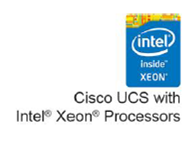Cisco’s Unified Computing System, originally designed for the datacenter is now optimized for Branch Office / Remote Office (ROBO), point-of-sale, and smaller IT environments with the announcement today of UCS Mini. This solution delivers servers, storage, and 10 Gigabit networking in an easy to deploy, compact form factor. Expandable to 15 servers, UCS Mini provides a scalable solution with the proven management simplicity of the award winning UCS Manager.
Senior Product Manager Tony Harvey (@TonyKnowsPower) and I recently discussed UCS Mini and how it fits into the overall product line.
https://www.youtube.com/watch?v=ZCB8_JjHji4
For Small to Medium Businesses
SMBs typically need fewer servers than large businesses. Little to no full time IT staff is also common issue. With UCS Mini, SMBs get the easiest to manage solution that can grow with them as their business succeeds. The ease of managing UCS Mini means more time can be spent running the business than worrying about arcane things such as firmware upgrades.
For Remote Office / Branch Office / Retail
Like SMBs, many remote or branch offices lack local IT staff. This makes the remote management features of UCS Mini ideal for these locations. If a user reports an issue, there is no need to send a technician onsite to perform the initial troubleshooting. UCS Manager can be remotely accessed from any computer on the network saving time, budget, and providing faster resolutions that keep users satisfied. If UCS Central is added to the solution, managing 100 locations is as easy as managing one.
For the Data Center
Sometimes compliance may mean physical hardware separation. This might be for companies that wish to outsource their server needs but cannot have the equipment located in the same domain as another company’s servers. Other companies might be very risk adverse and want to have very small failure domains.
UCS Mini TCO
How does UCS Mini stack up against a more traditional rack-mount environment used by many small businesses? I compared UCS Mini at various server counts and found both CapEx and OpEx savings.
https://www.slideshare.net/Ciscodatacenter/ucs-mini-tco
To recap the video, the main components of UCS Mini are:
- Cisco UCS B200 M3 Blade Server – delivering performance, versatility, and density without compromise, the Cisco UCS B200 M3 Blade Server addresses the broadest set of workloads.
- Cisco UCS 5108 Blade Server Chassis – a chassis can accommodate up to eight half-width Cisco UCS B200 M3 blade servers. Dual voltage AC (100-120V / 200-240V) and -48V DC power supplies means UCS Mini is ready for deployment anywhere.
- Cisco UCS 6324 Fabric Interconnect – providing the same unified server and networking capabilities as the top-of-rack 6200 Series Fabric Interconnect, the Cisco UCS 6324 Fabric Interconnect embeds the connectivity within the Cisco UCS 5108 Blade Server Chassis.
- Cisco UCS Manager – provides unified, embedded management of all software and hardware components in a Cisco UCS Mini solution.
Optional components include supported C-Series rack servers and UCS Central.
- Cisco UCS C220 M3 Rack Server – this 1RU server offers superior performance and density over a wide range of business workloads, from web serving to distributed database.
- Cisco UCS C240 M3 Rack Server – this 2RU server is designed for both performance and expandability over a wide range of storage-intensive infrastructure workloads, from big data to collaboration.
- UCS Central – manages multiple, globally distributed Cisco UCS and UCS Mini domains from a single pane.
To learn more about UCS Mini, contact your Cisco partner or account team or go to Cisco.com/go/UCSMini.

© 2014 Cisco and/or its affiliates. All rights reserved. Intel, the Intel logo, Xeon, and Xeon Inside are trademarks or registered trademarks of Intel Corporation in the U.S. and/or other countries.
Very nice scalable design, and of course even the SMB version (UCS mini) delivers on the network throughput.